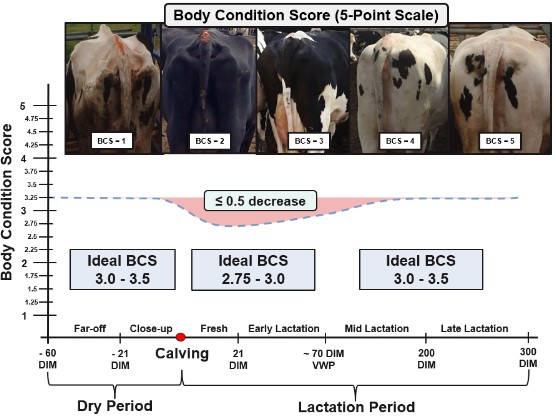By Adrian B Barragan
Excellent nutrition during lactation results in proper body condition in dry cows, which is a determining factor for a successful next lactation.
Excellent nutrition during lactation results in proper body condition in dry cows, which is a determining factor for a successful next lactation. Body condition is regulated by physiological and genetic mechanisms and can be easily influenced by environment (e.g. feeding levels, stocking densities). Good body condition in dry cows can only be achieved with correct management throughout the entire lactation.
The transition period is considered one of the most challenging times for dairy cows and extends from three weeks before parturition to three weeks after parturition (Drackley, 1999). One of the main challenges during this period is a physiological drop in intake coupled with an increase in the energy demands (mainly from the initiation of lactation), which causes a negative energy balance (Drackley, 1999). This predisposes dairy cows to mobilize fat tissue to make up for the lack of energy, which in turn decreases the body condition of these animals.
When cows are not properly managed (e.g., overstocking, inadequate nutrition, high incidence of diseases), the drop in dry matter intake is magnified and cows intensively mobilize fat tissue, subsequently developing ketosis, which is an important risk factor for metabolic and infectious diseases, as well as poor production and fertility (Benedet et al., 2019). Furthermore, due to intensive genetic selection toward higher milk yields in the last decades, the mobilization of adipose tissue has been greatly intensified (Cousillas et al. 2019).
Body condition score (BCS)
A system to subjectively measure cows’ body reserves was first designed in the 70s (Lowman eta al., 1973). Since then, multiple systems aiming to score the degree of apparent fat tissue accumulation were developed around the world. In the United States, a 5-point body condition score system that progresses in quarter points (0.25 points) has been widely adopted (Ferguson et al., 1994). You can learn more about the description and use of this scoring system through practical educational materials developed by Penn State Extension (Link: body condition in dairy cows).
Numerous studies suggest an optimum calving BCS between 3.0 and 3.5. A lower BCS than this may be associated with lower production and reproductive performance, while a higher BCS (>3.5) may reduce feed intake and increase risk for metabolic diseases (Lüttgenau et al., 2016). Furthermore, during the transition period animals should lose no more than 0.5 BCS points (Roche et al., 2009). A practical summary of the recommended BCS across the production cycle is provided in Figure 1.
Body condition and its relationship with health and performance
There is a general perception that thin cows may have more health issues; however, there is not much research supporting this hypothesis. Conversely, there are many studies suggesting that there is an association between over-conditioned cows and impaired immune response (Roche et al., 2009). This may be caused by the greater BCS loss post calving that is associated with over conditioned cows (Contreras and Sordillo, 2011).
It has been reported that fresh cows with BCS >3.5 have 30% greater odds of succumbing to milk fever than cows with BCS of 3.0 (Roche and Berry, 2006). This might be due to the decreased post-caving dry matter intake observed in cows with greater BCS (>3.5) and the higher demand of calcium for milk production (Roche et al., 2009). Additionally, cows with a BCS of >3.5 at calving are at a higher risk of developing ketosis compared to those with a BCS of 3.25 (Gillund et al., 2001).

Figure 1. Body condition score recommendations for lactating and dry dairy cows.
There are only limited studies that have evaluated the relationship between body condition and infectious diseases such as mastitis or metritis. For instance, in a study involving almost 10,000 dairy cows, cows that lost body condition during the dry period had a greater incidence of uterine diseases and indigestion (Chebel et al., 2018). Similarly, losing body condition during the dry period was associated with a higher likelihood of antimicrobial and anti-inflammatory treatments (Chebel et al., 2018). Furthermore, there is evidence that indicates that rapid loss of condition during the transition period may reduce the chances of recovery from infectious diseases (Contreras and Sordillo, 2011).
In addition to the negative effects that body condition loss has on animal health, losing body condition before or after calving affects the fertility of dairy cows. For instance, cows that lost body condition during the dry period had a lower pregnancy rate after first and second postpartum inseminations (Chebel et al., 2018); while a lower proportion of cows that lost body condition during the first 60 days after calving became pregnant compared to cows that maintained or gained body condition (Carvalho et al., 2014).
Body condition profile